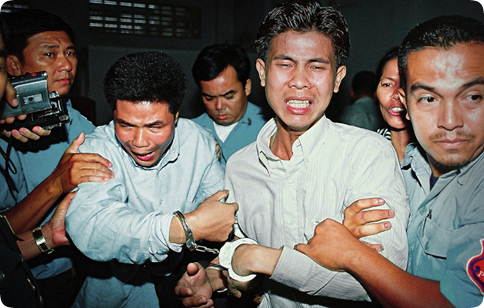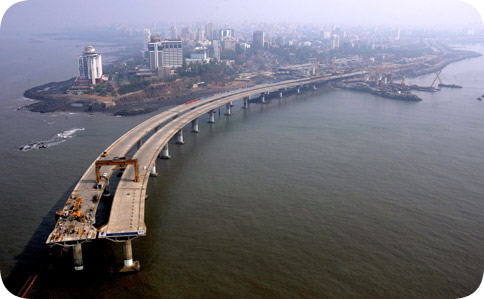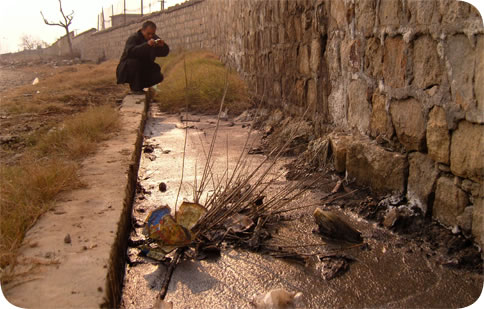|
Join Our List
|

|
|
|

|
LETTER FROM THE EDITOR
| |
First, I must apologize for the late appearance of this issue, which was delayed due to circumstances beyond my control. Also, note that there is no summer 2013 issue but that this issue and a double issue covering summer and fall will cover this year's summer issue. The reviews in this issue draw our attention to two films on Southeast Asia, and two films dealing with the largest Asian countries of India and China. Robert McKinley brings us two reviews, one a film treating current political conditions in Cambodia, and the other offering a look at mental health issues and family dynamics in Indonesia. The third review, by Kelly Alley, deals with a film about the growing pains of the Indian city of Mumbai (Bombay) especially as reflected in its transportation system in the context of rising automobile use and government efforts to meet these demands. The film Warriors of Qiugang, reviewed by Judith Shapiro, treats the environmental problems brought on by China's rapid industrialization, their impact on a town in Anhui Province, and the response of the villagers there. I want to thank the reviewers who wrote for this issue the time they spent providing their thoughts on these films.
William Londo
|
|
FILM REVIEW
| | |
Who Killed Chea Vichea?
Directed by Bradley Cox. 2010. 56 minutes.
In English and Khmer with English subtitles.
Reviewed by Robert McKinley.
 Who Killed Chea Vichea? Who Killed Chea Vichea? is an investigative masterpiece. The film's director, Bradley Cox, and his producers Rich Garella and Jeffrey Saunders are to be thanked and congratulated for this arresting documentary. They have let the rest of the world in on what all Cambodians already know: namely, that their lives under the Hun Sen government, though no longer the disaster of the Khmer Rouge years from 1975 to 1979 nor the calamity of the civil war years that followed through the 1980s to 1993, are still caught up in a terrifying existence in which might makes right. The full-time nightmares of the killing fields past have lessened to become more occasional, more contextualized. They are limited to situations where power is challenged, or is felt to be so. But they are no less horrifying and brutal for all this. Those deemed in the way will pay. One former hit man, interviewed in shadow, says many Cambodian corpses have already been fed to the crocodiles. Not just ten or even fifty. Many more!
One comes away from this film understanding that the killer of the much loved Cambodian labor union president Chea Vichea on January 22nd, 2004, Chinese New Years, in front of a news stand near his home in Phnom Penh, has never been brought to justice. In fact, the courts, in a compounding act of injustice , falsely convicted two innocent men of the crime. What makes this film work is its convincing presentation of the background of these two events: Chea Vichea's assassination in broad daylight and the trial and subsequent appeals of the two convenient scapegoats, Born Samnang and Sok Sam Ouen. Director Cox spent five years in Cambodia and had already been interviewing Chea Vichea in the period leading up to the 2003 elections. He knew of his staunch commitment to workers' rights in Cambodia and also of the threats to Vichea's life resulting from his fight for those rights. Vichea had opted to stay in Cambodia and support its 200,000 garment workers, whose wages were only around US$45 a month, in their demands for better pay and working conditions rather than flee. He had allied with the opposition leader Sam Rainsy against Hun Sen and the ruling Cambodia Peoples Party, CPP. In the July 2003 national election, no side had gotten a majority and the three leading parties, CPP, Sam Rainsy, and the Royalists, spent months bargaining over how to form a coalition government. Eventually the Royalists sided with the CPP, and Sam Rainsy lost out. Then came Chea Vichea's killing.
READ MORE...
|
| FILM REVIEW | |
Family Victim: The "Bad Coconut" of a Javanese Family
Directed by Robert Lemelson. 2010. 38 minutes.
In English and Indonesian with English subtitles.
Reviewed by Robert McKinley.

The title of Family Victim: The "Bad Coconut" of a Javanese Family draws on a Javanese proverb that says there is "a bad coconut in every bunch" or as the related Balinese proverb would have it "not all coconuts from the same tree have milk." This film shows with amazing sensitivity the complexities of a deviant personality within the strongly cooperative bonds of a large Javanese family. The one who is poorly adjusted, named Estu, has taken resources from his parents and siblings to support his gambling habit, he has often broken the possessions of others in destructive rages, and he has even threatened to kill his brother or his wife and their children through sorcery. Yet he feels that he is the one being misunderstood. He is the one not being listened to by his parents and siblings. He tries to tell them of his true feelings and anger by writing graffiti on the inside walls of his house and shop. The title "Family Victim" stems from one particular outburst. Despite the trouble he keeps causing his family, he is the victim! He explains that he has taken on all their misfortunes and they have taken on all his potential successes for themselves. So in his eyes he is a true family victim. On another wall he says he will get revenge. In tears his own sister tells of their mother having been driven to pray to God asking him to "please take Estu back," for they have done all they can to take care of him. Somehow they have failed and can do no more. From where has all this pain and bitterness come?
That is the question director Robert Lemelson and his two Javanese colleagues. Dr. Mahar Agusno and his wife Dr. Ninik Supartini , a psychiatrist and a psychologist respectively, try to answer in this film. Estu is in fact Ninik's own brother. He had been included in a sample of poorly adjusted individuals Agusno and Supartini had been studying in central Java, Indonesia. Their joint research with anthropologist Lemelson is on culture and mental illness. Their intimate acquaintance with this case and their mutual sensitivity with regard to Estu and his family members makes for an exceptionally revealing account. It is frank, deeply well informed, and carried out over many years so as to have the effect of being an in depth longitudinal study. We get to see what can happen over time and in unforeseen ways in such difficult relationships as these.
READ MORE...
|
| FILM REVIEW | |
Mumbai: Traffic
Produced by Danish Radio. 2011. 60 minutes.
In English.
Reviewed by Kelly D. Alley.

This is a realistic film about the serious problem of transportation congestion in Mumbai, one of the world's most populated cities. It is humanistic in its respect for the people it features and is also humorous at times about the unique and sometimes conflicting conjunctions that this complex transportation problem inflicts on variously positioned residents. The film presents many dimensions of the transportation problem through non-scripted portrayals of key actors as they debate plans and implement projects to alleviate traffic congestion in and around the main commercial hub of the city.
The main characters in the film are a bureaucrat of a government public sector transportation department, a citizen activist and her colleagues, and a street vendor and his family. The film chronicles their lives as they evaluate the planning and construction of the highway links proposed to alleviate vehicle congestion. The film convincingly shows how a sea bridge and flyover become infrastructure center points around which the city's citizens converge. The film also conveys the individual and institutional struggles involved in building large scale infrastructure to meet the burgeoning desires of a large population, while showing the inevitable conflicts and differences of opinion that arise in the process.
READ MORE...
|
| FILM REVIEW | | |
Warriors of Qiugang
Directed by Ruby Yang and written by Thomas Lennon. 2010. 39 minutes. In Mandarin with English subtitles.
Reviewed by Judith Shapiro.

An expanding body of excellent documentary films on Chinese environmental issues should be included in courses on China and global environmental issues. To name just a few (in order of release date) , these include Mardi Gras: Made in China (2005; click here for AEMS review), a sly, slightly off-color documentary contrasting the careless wastefulness of drunken New Orleans revelers with the repressive lives of the sweatshop girls who manufacture plastic beads ; Manufactured Landscapes (2006), a haunting if slow-moving film that forces the consumer/viewer to confront the detritus of global production; Waking the Green Tiger (2011), a fascinating documentary that interweaves civil society anti-dam activism and Mao-era footage; and Beijing Besieged by Waste (2011; click here for AEMS review), a moving portrait of the lives of subsistence-level garbage pickers. I have used all of these with success in the classroom; among them, Warriors of Qiugang, the documentary here reviewed, is one of the most conducive to classroom use because it is short (39 minutes) and readily available for free at Yale Environment 360 (e360.yale.edu), which co-produced the film.
Directed by Ruby Yang and written by Thomas Lennon, Warriors of Qiugang tells a compelling story of pollution and its impact on 'ordinary' Chinese farmers and their lives, and provides a great basis for classroom conversations about civil society, Chinese politics and culture, and environmental justice. It covers a great deal of ground with a fairly light touch, bringing the viewer into an Anhui province village in the township of Bengbu, where three factories have manufactured fertilizers and pesticides since 2004, occupying a third of the area of the village, and contaminating the water and air to such an extent that fish die, school children cannot breathe, and people die of cancer at a high rate. (The Baojia waterway feeds directly into the Huai River, one of China's most notoriously polluted waters.)
READ MORE... |
| AsiaLENS FILM SERIES | |
AsiaLENS is a series of free public film screenings and lecture / discussion programs -- organized by AEMS in collaboration with the Spurlock Museum -- presenting recent documentary and independent films on issues reflecting contemporary life in Asia. Local and visiting experts introduce the films and lead audiences in post-screening discussions.
All AsiaLENS screenings are FREE and open to the public.
Our upcoming screenings are:
Beijing Besieged by Waste
Tuesday, September 10, 2013 - 7:00 pm
Spurlock Museum, 600 S. Gregory Street, Urbana IL
Tokyo Waka: A Secret Poem
Tuesday, October 8, 2013 - 7:00 pm
Spurlock Museum, 600 S. Gregory Street, Urbana, IL
A Perfect Soldier
Tuesday, November 12, 2013 - 7:00 pm
Spurlock Museum, 600 S. Gregory Street, Urbana, IL
CLICK HERE FOR MORE INFO
|
| WEBSITE: DIGITAL ASIA | |  Digitial Asia, a website bringing documentary films on contemporary East Asia to the classroom, has been launched by the Asian Educational Media Service (AEMS). In providing free access to excerpts of scholar made films on Asia, along with downloadable curriculum materials, Digital Asia offers high school and college educators an easy way to incorporate today's issues in Asia as part of their lesson plans. Digital Asia can be found at: www.digitalasia.illinois.edu Digital Asia is funded by the Freeman Foundation of Stowe, VT., New York City and Honolulu and by the IL/IN East Asia National Resource Center funded by U.S. Department of Education Title VI. |
|
| SUPPORT AEMS | | AEMS invites our supporters to make targeted donations to enhance our holdings and public programs. A donation of $30 can be used to purchase a film for the AEMS library. $300 will sponsor an AsiaLENS screening on campus or in the Champaign-Urbana community. $500 will help underwrite a film and curriculum materials in Digital Asia. Donations for specific materials or events will be acknowledged both in News and Reviews and at sponsored events. Thank you for your ongoing support of AEMS.
Follow this link to make an online donation.
PLEASE NOTE:
You will be directed to the CEAPS Giving page.
After clicking "Continue With Your Donation" you will find a Special Instructions section where you can highlight "yes" under the question "Do you have other instructions for processing your gift?"
A text box will open where you can direct your gift to the following:
AEMS - Asian Educational Media Service Fund -or- Digital Asia Fund
|
NEWS AND REVIEWS
| | Previous issues of News and Reviews:
Electronic newsletters - September 2010 - Spring/Summer 2013
Archived print newsletters - Spring 1998 - Fall 2009
|
| ABOUT AEMS | | Media Production Group
In addition to hosting film screenings, AEMS also produces and distributes its own materials under the brand name Media Production Group (MPG) . These are short educational videos and DVDs about an aspect of Asian culture suitable for classroom use and accompanied by curriculum.
Database
AEMS maintains a searchable database of over 6,000 films about Asia, including length, format, distributor and synopsis.
Library
AEMS library, through its connection to the Lincoln Trails library system, circulates videos and DVDs locally from its collection of more than 2,000. |
| Asian Educational Media Service
805 W Pennsylvania Ave, Urbana, IL 61801
|
|